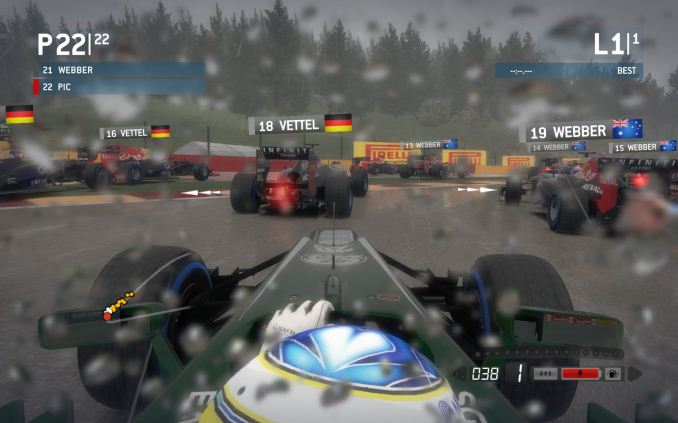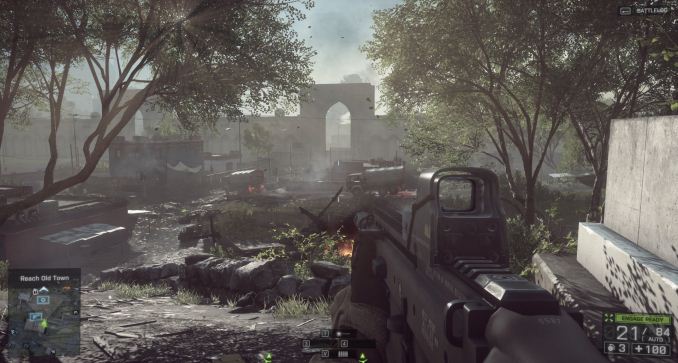MSI B85M ECO Review: Aiming Green at $73
by Ian Cutress on November 26, 2014 8:00 AM EST- Posted in
- Motherboards
- MSI
- B85
- ECO
Gaming Benchmarks
F1 2013
First up is F1 2013 by Codemasters. I am a big Formula 1 fan in my spare time, and nothing makes me happier than carving up the field in a Caterham, waving to the Red Bulls as I drive by (because I play on easy and take shortcuts). F1 2013 uses the EGO Engine, and like other Codemasters games ends up being very playable on old hardware quite easily. In order to beef up the benchmark a bit, we devised the following scenario for the benchmark mode: one lap of Spa-Francorchamps in the heavy wet, the benchmark follows Jenson Button in the McLaren who starts on the grid in 22nd place, with the field made up of 11 Williams cars, 5 Marussia and 5 Caterham in that order. This puts emphasis on the CPU to handle the AI in the wet, and allows for a good amount of overtaking during the automated benchmark. We test at 1920x1080 on Ultra graphical settings.

Bioshock Infinite
Bioshock Infinite was Zero Punctuation’s Game of the Year for 2013, uses the Unreal Engine 3, and is designed to scale with both cores and graphical prowess. We test the benchmark using the Adrenaline benchmark tool and the Xtreme (1920x1080, Maximum) performance setting, noting down the average frame rates and the minimum frame rates.

Tomb Raider
The next benchmark in our test is Tomb Raider. Tomb Raider is an AMD optimized game, lauded for its use of TressFX creating dynamic hair to increase the immersion in game. Tomb Raider uses a modified version of the Crystal Engine, and enjoys raw horsepower. We test the benchmark using the Adrenaline benchmark tool and the Xtreme (1920x1080, Maximum) performance setting, noting down the average frame rates and the minimum frame rates.

Sleeping Dogs
Sleeping Dogs is a benchmarking wet dream – a highly complex benchmark that can bring the toughest setup and high resolutions down into single figures. Having an extreme SSAO setting can do that, but at the right settings Sleeping Dogs is highly playable and enjoyable. We run the basic benchmark program laid out in the Adrenaline benchmark tool, and the Xtreme (1920x1080, Maximum) performance setting, noting down the average frame rates and the minimum frame rates.

Battlefield 4
The EA/DICE series that has taken countless hours of my life away is back for another iteration, using the Frostbite 3 engine. AMD is also piling its resources into BF4 with the new Mantle API for developers, designed to cut the time required for the CPU to dispatch commands to the graphical sub-system. For our test we use the in-game benchmarking tools and record the frame time for the first ~70 seconds of the Tashgar single player mission, which is an on-rails generation of and rendering of objects and textures. We test at 1920x1080 at Ultra settings.
















40 Comments
View All Comments
Jaaap - Wednesday, November 26, 2014 - link
For these ECO boards it would be very interesting to get and idle power for a setup without external videocard.Jaaap - Wednesday, November 26, 2014 - link
Arg i should read better: 21W minimumklagermkii - Wednesday, November 26, 2014 - link
Thanks for showing separate idle and load power usage in the review and not just delta.bill.rookard - Wednesday, November 26, 2014 - link
The area I think where this would do fairly well would be as a SMB server. I know I tend to keep things for far longer than 5 years which would be the break even point on the cost - once they have something that works, and works well (and works correctly) they'll leave it in place until it dies, and for something as simple as file serving, you just want something durable and reliable.mike_m_ekim - Friday, December 12, 2014 - link
Another great use is a HTPC. My HTPC uses a 35-watt haswell CPU. Passive cooling isn't an option because of location, so fans are required. Another 10 watt reduction in system heat would allow the fans to run just a little slower, making my nearly silent PC even quieter.mike_m_ekim - Friday, December 12, 2014 - link
One other thing, my HTPC is on 24/7 and transcoding almost all the time. I would see a $25 savings in electricity over 3 years, and an HTPC should be able to last much longer (because it's just an appliance). The cost savings would be secondary (noise being the biggest factor).MrSpadge - Wednesday, November 26, 2014 - link
My PC is number-crunching 24/7, so saving 12 W would save me about 6€/year (yeah, no fracking in Germany). A Z97 ECO could be interesting, because even with massive undervolting to ~1.0 V, current Intel CPUs are still asking to be OC'ed to ~4.0 GHz. I couldn't do that with a B chipset.DanNeely - Wednesday, November 26, 2014 - link
Is your math right? Your cost saving number seems low. For 24/7/365 operation a 1W load corresponds to 8.76 kwh/year; at an electricity price of 11.5 cents per kwh (reasonably close for most of the US) it works out as a dollar per wattyear or $12/year savings. My understanding is that German electric prices are several times higher, and am wondering if you lost a zero in your calculations.Jaaap - Wednesday, November 26, 2014 - link
You're right. One WattYear is approx 2 euro.MrSpadge - Wednesday, November 26, 2014 - link
8.76 kWh for 11.5 US-ct -> 1 W = 1 $/year in the US8.76 kWh for 23 EUR-ct -> 1 W = 2 €/year in Germany
... the cost is higher over here, but not an order of magnitude :)